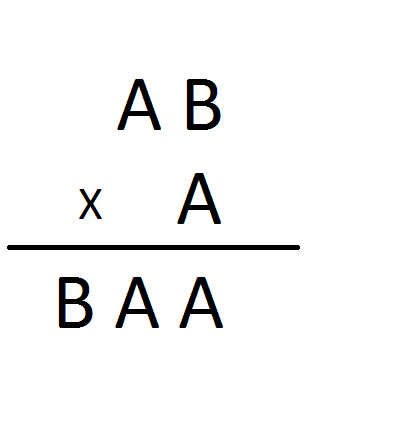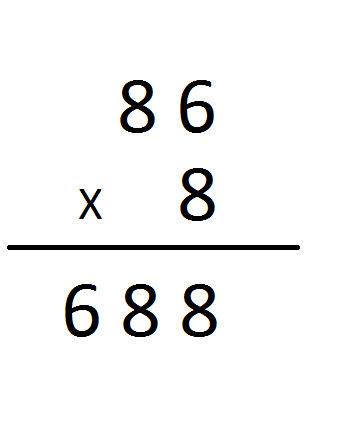Can you figure out what A must be and what B must be in the multiplication problem below to make it correct? The answer is unique.

Solution to the Problem:

James Alarie pointed out that the answer is not unique, since it was not specified that A and B had to be different integers. So, another answer would be A = 0 and B = 0.
Lisa Greene sent in this excellent analysis of the problem:
"I found the answer using various statements that can be shown to be true to telescope the solution.
The first statement I used was that neither A nor B can be zero. If A is zero then the resultant product will simply be zero rather than a three digit number (though I would argue that if we were being pedantic and used leading zeroes then A=0 and B=0 could be a possible solution) and B cannot be zero because 0×A would always result in 0 rather than A. There are now 81 possible combinations of A and B (there were 100 to begin with).
The second statement I used was that A must be greater than B. This can be shown to be true by re-arranging the problem into AB = BAA÷A. In order to return a two digit solution to a division of a three digit numerator by a one digot denominator, the one digit denominator (A) must be greater than the first digit of the numerator (B). There now remain 36 possible combinations of A and B.
The third statement I used was that A must be greater than 3, or else a two digit solution would result from AB×A given that A>B. There now remain 33 possible combinations of A and B.
The fourth statement was that B cannot be 2, 4, 5, 7, 8, or 9. B cannot be 2 because no number times 2 will return itself in the ones place as is needed for A×B to return A for the ones place. B cannot be 4, 5, 7, 8, or 9 for the same reasons that it cannot be 2 (or at least it cannot be while retaining A>B). There now remain 10 possible combinations of A and B.
The fifth statement was that if B is 1 then A must be 4 because 4 is the only number that when squared has a 1 as a leading digit (the leading digit will not change for B=1 because when B=1 A×B will always be <10, so there will be no carrying over from A×B to add to A^2). There now remain only three possibilities for A and B.
I then simply checked all three remaining possibilities (being A=4, 5, and 8 and B=1, 3, and 6, respectively) and found A=8 and B=6 to be the correct solution."
Correctly solved by:
| 1. Anna Vice and Eliza Sheffield | Tuscaloosa, Alabama |
| 2. Brooke German | Marshall, Wisconsin |
| 3. James Alarie | Flint, Michigan |
| 4. Susan KM Amy Hunt | ---------- |
| 5. Saketh Malyala | ---------- |
| 6. Lisa Greene | ---------- |
| 7. Ivy Joseph | Pune, Maharashtra, India |
| 8. Claudia Gibson | Jacksonville, Florida |
| 9. Brijesh Dave | Mumbai City, Maharashtra, India |
| 10. SreeRoopa Sankararaman | Singapore, Singapore |
| 11. Dhanshri Patel | Ahmedabad, Gujarat, India |